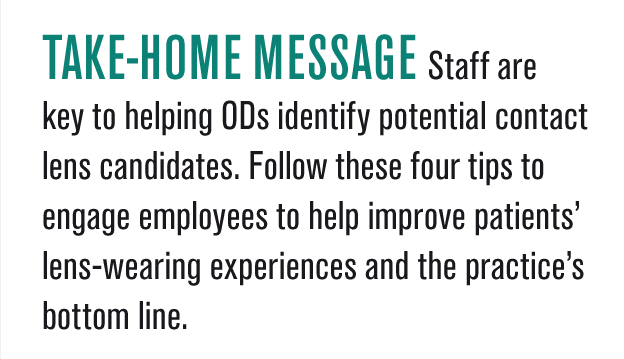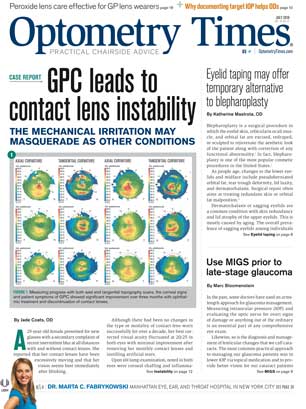4 tips to help staff identify contact lens candidates
Staff are key to helping ODs identify potential contact lens candidates. Follow these four tips to engage employees to help improve patients’ lens-wearing experiences and the practice’s bottom line.



From the front desk, to the technician, to the optometrist, all staff should be well-educated on the visual needs of today’s patients as well as on the latest technology in contact lenses and best practices for identifying potential contact lens candidates. ODs should not assume that determining a patient’s interest in contact lens wear is only their job-it’s everyone’s job.
Follow these four tips when engaging employees to help identify patients who may be good contact lens candidates.
1. Involve all staff in contact lens education
Ensuring that all staff is knowledgeable in the latest contact lens technology is imperative in identifying and securing contact lens candidates and contact lens upgrades. In our practice, doctors and staff don’t assume that doing so is only one person’s job-it’s everyone’s job. Consider incentivizing staff members to learn more about innovative contact lens advancements, which in turn will help them best meet the needs of the patients in the practice.
One way to better meet the needs of the patients is to work with local sales representatives to educate the staff on the latest contact lens products and technology on the market.
Our office hosts a complimentary breakfast staff meeting during which contact lens sales representatives discuss the latest lens technology. Our staff appreciates the invitation to join because they can learn about something new on the market while having the opportunity to ask representatives questions. By hosting these open meetings, sales reps can educate staff to understand what market needs new lens technologies are fulfilling, providing them with the necessary data to cater to all types of patient needs and lifestyles.
Related: 5 methods to drive contact lens compliance
Another route to involve your staff is providing hands-on training. This may help them feel even more comfortable when speaking about the product benefits with patients. Fit your staff with the latest in contact lens technology to provide them the opportunity to become clinically comfortable with the lenses and see how they perform.
As an example, a contact lens manufacturer extended its product line with a toric lens design. Working with our sales representative, we organized an all-staff event to discuss the features and benefits of the latest toric lenses and the importance of having completed product portfolios. Following the session, a few staff members were fitted with the lens, and now the entire team feels confident in approaching patients about the possibility of wearing these contact lenses.
2. Get to know patients and their lens wear habits
Taking the time to get to know patients and understanding their contact lens-wearing habits should be a priority for the entire staff, not just the doctor.
This understanding begins when a patient first schedules his appointment. Arm your staff with prompts on how they can naturally weave in questions about patients’ glasses and contact lens-wearing habits. This communication may happen through email, over the phone, and at the office during the appointment itself.
For example, if a patient schedules an appointment to update her contact lens prescription, the receptionist can share that the office has the latest in contact lens technology and that the doctor looks forward to discussing these lenses during the patient’s upcoming visit.
If a patient is looking to update his glasses, our staff asks about his experience with contact lenses (or lack thereof) to share with the doctor prior to the appointment.
For example, a staff member might say, “I see your appointment is specific to your current glasses prescription, and your records show that you have been dealing with presbyopia. Would you be interested in learning more from your doctor about innovative contact lens technology that is helping other patients with similar vision concerns see comfortably and clearly?”
In addition, when patients arrive to the office for their appointments, staff should reignite the conversation around contact lenses without being pushy. This can happen by the staffer asking patients if they brought their glasses or contact lenses to the visit and referencing the phone conversation patients had previously with staff about trying new contact lens technology.
Depending on a patient’s experience with contact lenses, staff can position the question as a potential solution for their visual correction. “I understand that glasses work for you, but many of our patients are wearing contact lenses to address their visual needs and rid themselves of the cumbersomeness of readers.”
Once the patient arrives in the examination room with the optometrist, the contact lens conversation has been raised multiple times. Based on the information the rest of the staff could obtain, the optometrist can present innovation in contact lenses specifically for that patient, noting the reasons that particular lens provides benefit to their patient’s needs (e.g. lifestyle, visual correction, comfort, cost and convenience, and so on).
3. Streamline in-office promotional material
Surface clings, promotional videos and in-office educational material should reflect the contact lenses that your team is discussing with patients.
Remind staff that brochures on display should promote the innovative technology in contact lenses that the office prescribes. Staffers should freely distribute this material to patients who may be interested in contact lens wear or who are wearing older contact lens technology. Most contact lens manufacturers provide patient rebates, making the potential switch to contact lenses or upgraded materials a cost-effective win-win for the patient.
Related: Increase contact lens comfort by paying attention to the lids
As a team, decide which contact lenses staff should help promote and make sure that promotional materials are consistent with this message.
4. Harness the power of the thank-you note
A patient’s experience after leaving the office is just as important as her time during her visit.
In addition to sending a “thank you” email expressing our staff’s appreciation to patients for visiting our office, our team continues the contact lens conversation with follow-up questions about the fit and comfort of their trial lenses.
This is an example:
“We’re so glad that you decided to experience [company and brand name] astigmatic contact lenses. We would love to hear how your experience with the contact lens is going so far. Do you notice you are able to wear the lens comfortably throughout the day? Has this helped reduce halos and glare while driving at night? If you have any questions about the contact lens, we would be happy to schedule a time for you to speak with a staff member.”
Our team will also follow up with a phone call to patients to answer any questions they have about the lenses and to schedule their next annual exam. Through this continuous contact with patients, we not only help their transition to a new contact lens go smoothly, but also we reinforce that our team is here to provide them with the best support to ensure they obtain the best vision possible.
Making it happen
As optometrists begin to train and educate their staffs on the importance of how they communicate with potential contact lens patients, remind them of these three tips:
• Everyone in the office plays a part in optimizing the patient experience.
• Understanding the individual patient’s needs and prescribing innovative technology will go a long way to meet the patient’s needs.
• It should be the common goal to ensure that patients leave the office thinking how the whole team helped them to have a higher quality experience.

Newsletter
Want more insights like this? Subscribe to Optometry Times and get clinical pearls and practice tips delivered straight to your inbox.